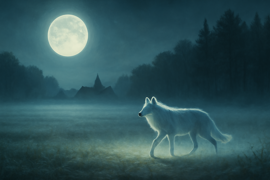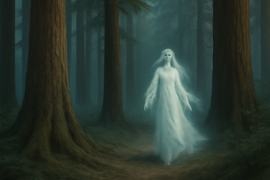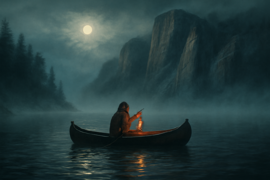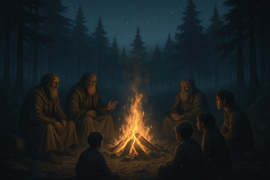Introduction
Under a vast canopy of towering pines and whispering oaks, a circle of elders settles around a crackling fire. Their faces, lined with years of laughter and sorrow, glow in the dancing light. Beyond the ring of stones, the forest breathes a quiet rhythm, alive with unseen footsteps and half-heard sighs. This is where the boundary between the world of the living and the realm of spirits thins to a gossamer veil, where ancestral voices drift on the night breeze. The children, bundled in deerskin blankets, lean forward, eyes wide and hearts pounding as the first tale begins. In these hallowed gatherings, time itself seems to pause. Tales of spectral wolves, phantom canoes, and misty apparitions rise from the embers, carrying warnings and blessings from those who came before. These stories are not mere entertainments; they are living threads woven into the fabric of tribal identity. Each ghostly figure—be it a solitary wanderer sorrowful at love lost, a guardian spirit protecting sacred lands, or a trickster weaving cautionary lessons—serves as a bridge between past and present. As the wind carries the crackle of firelight into the night, listeners feel the ancestors’ presence keenly. A twig snaps beyond the glow, and for a moment, every breath stills. It is in that hush that the ghosts speak, urging respect for the natural world, unity among kin, and courage when the shadows gather. Tonight’s stories will traverse plains washed by moonlight, redwood groves heavy with mist, and silent lakes mirrored by distant peaks. By dawn’s first light, listeners will carry home not just tales of spectral wonder, but the guiding wisdom of generations etched into every tremor of the wind.
The Silent Wolf of the Moonlit Plains
First Paragraph:

The plains lay bathed in silver under a full harvest moon, grass blades whispering secrets as they swayed. Travelers reported a lone wolf, larger than any living creature, its pelt pale as drifting fog. When the phantom animal appeared, its eyes glowed with an ancient intelligence that stirred both awe and dread. People said it roamed the grass sea in silence, yet its howl could shatter the stillness of midnight with the sorrow of a thousand lost souls. Elder Nitaawich remembers her grandmother’s tale: how hunters once chased a ghost-wolf across dunes, desperate to prove their bravery. The beast led them in circles until dawn, its mournful cry blending with a sudden gust that carried voices of the departed. Some fell to their knees, broken by grief from lives long forgotten; others vanished without a trace. From that night on, the wolf became a guardian specter—a warning against pride and disrespect for the land. Hunters left fresh tobacco offerings where the grass met the sky. Generations learned not to pursue what must be honored at a distance.
Second Paragraph:
In one unforgettable account, a young warrior named Makwa set out to test his courage. Armed with a spear carved from sacred cedar and draped in a wolf-hide cloak, he ventured under the moon’s watchful eye. As he crested a rise, the Silent Wolf emerged, its form shifting like mist, fur rippling with ghostly luminescence. Makwa’s heart thundered in his chest, but he held his ground. Rather than advancing, the wolf sat and stared, its howling sigh echoing across the plains. Makwa offered a prayer for guidance, then placed his spear at the creature’s feet and knelt. The wolf’s ears perked; in his stillness, Makwa heard a faint melody born of wind and memory. It was the lament of ancestors, each note urging humility and reverence for the earth. After a moment that felt like lifetimes, the beast rose and vanished into the night, leaving behind only hoofprints that faded with the morning dew.
Third Paragraph:
Scholars and storytellers debate whether the Silent Wolf is a single spirit or a lineage of spectral guardians. Some tribes say the wolf appears to warn of natural disasters—a foreshadowing howl before drought or flood. Others believe it guides lost souls to the afterworld, patrolling the boundary between life and death. When children see streaks of pale mist on moonlit grass, elders hush them, recalling how one reckless boy chased the illusion until he wandered too far into thunderheads and nearly drowned in rising waters. They say the wolf circled above him, cloaked in storm clouds, directing him back to safety with a mournful howl. At dawn, the tribe found him shivering by the riverbank, eyes wide with wonder and fear.
Fourth Paragraph:
The story’s power lies not in the creature’s spectral majesty, but in its message: the land is alive with spirits who demand respect. The Plains people learned to speak softly on moonlit nights and to offer prayers of tobacco at each turn. They fashioned talismans inscribed with wolf tracks to carry protection on solitary journeys. And around fires, families sang songs of the Silent Wolf, reminding every child that wisdom often comes in the shape of what we fear most.
Fifth Paragraph:
Even today, when the moon climbs high and the grass shimmers with frost, some swear they glimpse a pale wolf trailing the horizon. In those hushed moments, the wind carries its ancient lament across the plains, urging listeners to honor the rhythms of nature and to walk humbly under the watchful gaze of ancestors.
The White Lady of the Redwood Grove
Paragraph One:

Deep within a grove of ancient redwoods, where sunlight filters through towering trunks and carpeted ferns cling to the forest floor, a legend persists of a White Lady whose mournful figure glides between columns of bark. Hunters who stray too far from beaten trails speak of a pale form, long hair drifting like smoke, garments stained by tears long dried. When she appears, the air chills and birds fall silent, as if even feathered wings dare not disturb her grief. They say she was once a young woman named Aiyana, whose heart was tethered to two worlds—land of the living and realm of spirits. After losing her betrothed to a sudden illness, she wandered these woods in despair, refusing to leave until she could join him. The forest heard her pleas and transformed her sorrow into a spectral presence that lingers still.
Paragraph Two:
In one account, a woodcutter discovered her weeping at dawn beside a moss-covered outcrop. Her tears glistened like dew, and her voice carried the ache of a thousand autumns. He approached with caution, offering sweetgrass and a song of healing passed down by his mother. As he sang, her form trembled, and frost bloomed on nearby leaves. Though he meant to comfort, the weight of her sorrow proved too great; the ground split with a thunderous crack, and the cutter barely escaped as the grove swallowed his footprints. Since then, villagers leave strands of white cloth tied to fallen branches, hoping to soothe her solitude and spare travelers from her wailing lament.
Paragraph Three:
Tribal wise women teach that the White Lady’s story holds a lesson of balance between love and letting go. Aiyana’s devotion was pure, yet unchecked grief can tether a soul too tightly to loss, preventing both life and death from unfolding as they must. Offerings of sage, ribbons, and hushed prayers are ways to acknowledge sorrow without succumbing entirely to despair. Each ribbon fluttering in the breeze whispers a promise to remember the lost while embracing the gift of each new sunrise.
Paragraph Four:
Some nights, when the moon is hidden, guides leading groups through the grove report hearing soft footsteps and half-remembered lullabies. They leave small bowls of fresh water and wildflowers in clearings where moonlight never reaches. At dawn, the offerings are gone, and tiny footprints, like those of a child, mark the soft earth. The White Lady, they say, put these gifts in her shroud, gathering tokens of kindness to carry into the next realm.
Paragraph Five:
Today, visitors who wander the redwood paths pause by lantern light to share her tale, leaving strands of white cloth on low branches as both tribute and rite. Children press their palms to bark, hoping to feel the pulse of ancient life, while elders chant prayers that Aiyana’s spirit finally finds peace. In doing so, they keep alive a story woven from love, loss, and the gentle rhythm of letting go.
The Phantom Canoe on Shadow Lake
Paragraph One:

Shadow Lake lies at the valley’s heart, cratered by ancient glaciers and hemmed by granite cliffs clothed in cedar and hemlock. Its still waters mirror the sky so perfectly that day merges with dusk and the boundary between earth and reflection vanishes. On nights when mist drifts across the surface, villagers hear the creak of oars and the hollow echo of paddles slicing through water. Yet when they rush to the shore, seeking the source, the lake lies empty save for soft ripples fanning out where no boat floats. Elders recount how, centuries ago, a band of canoemen set out under a crimson sunset to retrieve a sacred artifact from an island shrine. A sudden gale rose, capsizing every vessel. Only their cries reached the shore, swallowed by wind and wave.
Paragraph Two:
Many years later, fishermen found carved paddles at the water’s edge, polished smooth by time and tide, their shapes too precise to be natural. That night, as a solitary figure guided a canoe beneath oaks by lantern glow, his kin saw the lantern flicker and vanish. Come morning, his boat drifted back to shore, empty but for a single cedar paddle laid across its bow. No footprints led to or from the lake. Even now, canoes tethered at the dock sometimes list as if an unseen presence boards, and on mist-laden nights, faint drumming and voices echo over the water.
Paragraph Three:
Listeners gather near the shoreline to offer tobacco prayers at dusk, casting yellow petals into the currents. They believe the Phantom Canoe’s crew seeks passage to the spirit world, and these offerings guide their lost souls safely to the island shrine. Youths dared each other to paddle out at midnight, yet many turned back when lanterns bobbed on the horizon, unmanned and beckoning.
Paragraph Four:
Mountain guides warn newcomers: respect the lake’s silence, and never whistle after dark, for it may draw the canoe closer. Those who do hear low whistles report chilling sensations of a vessel drawing alongside, as if inviting them aboard. Some travelers say they felt slender hands offering them seats, only to be released by the first crow of a raven perched on nearby rocks. The morning find them shivering on the dock, hearts pounding with questions and gratitude for escape.
Paragraph Five:
In winter, when ice seals the lake’s surface, the haunting music of drums and voices carries faintly through frozen woods. It reminds everyone that Shadow Lake remembers the wronged, and that in the hush of a snowy night, compassion for the restless dead lights a path through the darkness. This is why families come each year with oars tied with red sinew—so that even a phantom canoe may find its way home.
Conclusion
As dawn paints the sky in hues of rose and gold, the embers of the night’s fire glow faintly, and listeners rise, carrying with them the weight and wonder of ancestral whispers. Each ghost story—of the Silent Wolf, the White Lady, and the Phantom Canoe—serves not merely as chilling entertainment, but as living lessons etched into the land itself. Through these legends, people learn humility before forces greater than themselves, the delicate balance between holding on and letting go, and the enduring promise that the departed watch over those who walk the earth with respect. These tales remind us that the boundary between worlds is woven from memories, prayers, and the songs we sing when shadows gather. They teach that grief, love, and the quest for understanding unite us across generations. When the wind rustles in pine needles or the moonlight glimmers on still waters, we remember to pause, to honor the past, and to speak softly, for the ancestors listen still. In sharing these spectral stories, we keep alive a cultural heritage, forging connections between youth and elder, land and spirit, the living and the unseen. Let this gathering’s echoes carry forward, guiding each traveler under the watchful gaze of ancestors, so that fear becomes reverence, and every whispered legend finds new life in hearts yearning for wisdom and wonder alike.

















